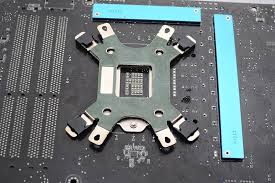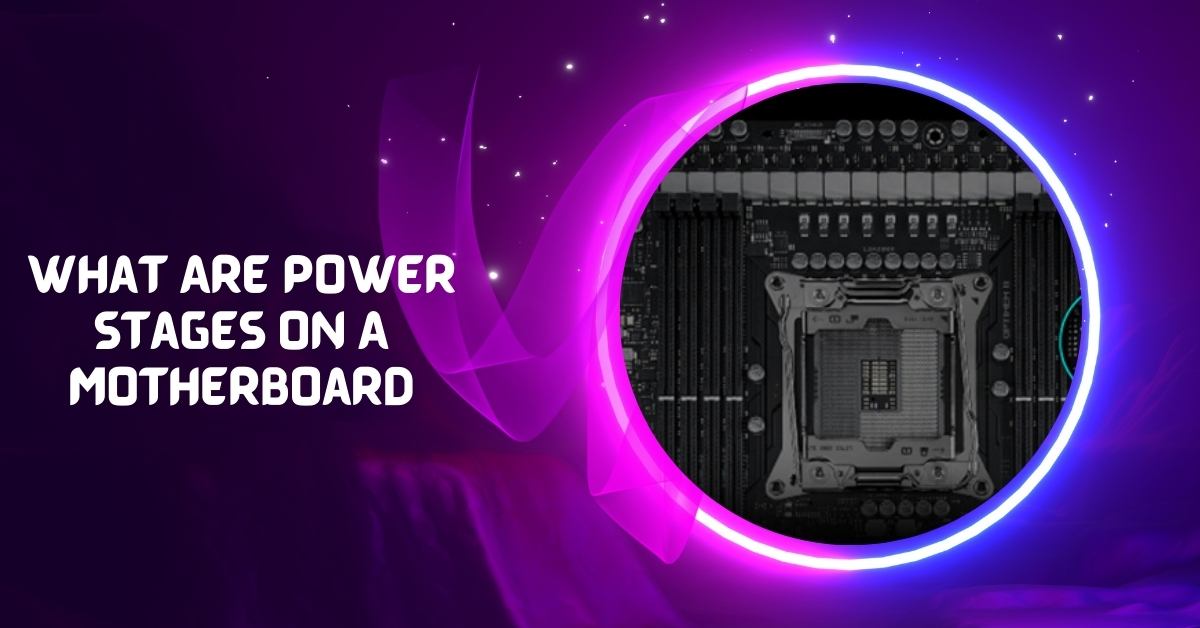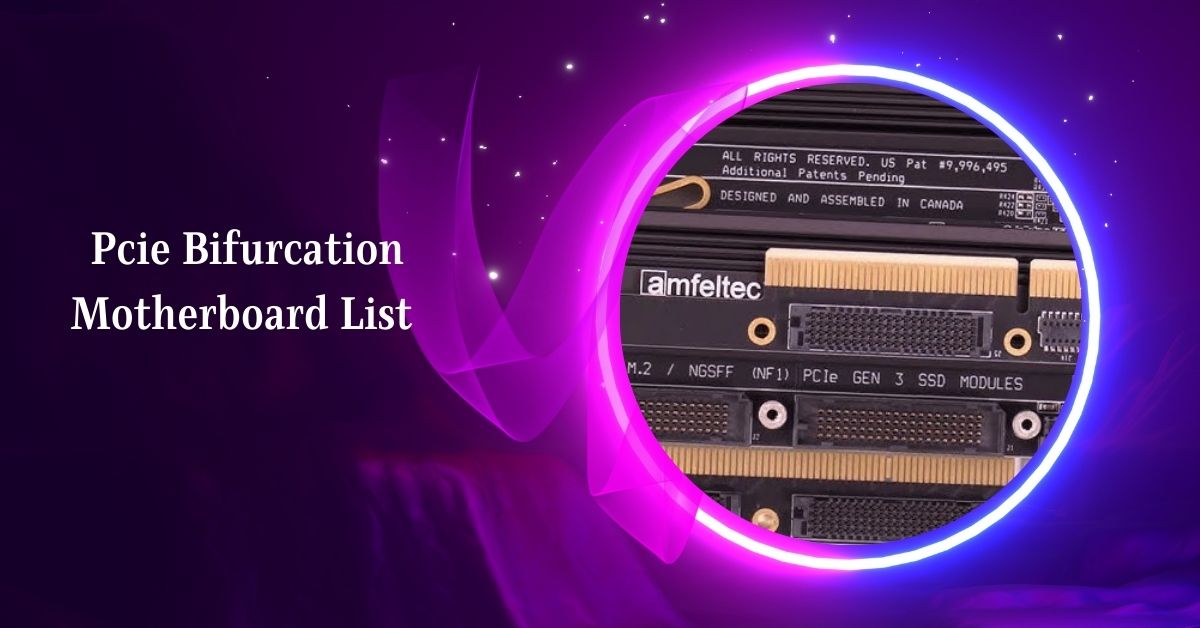Backplate motherboards are a crucial component of any computer system, providing the foundation upon which all other hardware components are installed.
A backplate motherboard is a protective plate pre-installed on the rear side of most AMD motherboards. It provides structural support, aids in cooling, and ensures proper CPU installation, making it essential for system stability.
In this article, we will explore “What Is Backplate Motherboard”
What Is A Backplate For On A Motherboard?
A backplate on a motherboard serves as a sturdy base for connecting various components like ports and slots.
It’s like the backbone of a computer, keeping everything in place. This backplate makes installing and securing different parts easier without worrying about them wobbling or getting loose.
Think of it as the foundation of a house; without it, things might fall apart. So, a backplate is like a support system for your computer’s insides.
Components Of A Backplate Motherboard

1. Mainboard
The mainboard is like the heart of the computer, where all the essential components connect. It’s a giant circuit board with many tiny pathways that let information flow between the CPU, RAM, and other parts.
2. Input/Output Ports
These are like the doors and windows of your computer, where you plug in things like keyboards, mice, monitors, and USB drives. They’re essential for communication between your computer and the outside world.
Read: Do You Need To Reinstall Windows After Replacing Motherboard
3. CPU Socket
The CPU socket is where the brain of your computer, the CPU, sits. It’s like a special seat designed just for the CPU, with all the connections it needs to talk to the rest of the computer.
4. RAM Slots
RAM slots are like beds for your computer’s memory. This is where the RAM sticks go, so your computer can remember things while it’s turned on. The more RAM slots you have, the more memory your computer can have.
5. Expansion Slots
Expansion slots are like extra rooms in your computer’s house. They’re spaces where you can add graphics cards, sound cards, or additional USB ports to customize your computer to suit your needs.
6. Power Connectors
Power connectors are like the electricity outlets in your computer. They’re where you plug in the cables that provide power to all the different parts, like the CPU, graphics card, and motherboard. Without power connectors, your computer couldn’t turn on or do anything.
Are All Motherboard Backplates the Same?
No, not all motherboard backplates are the same. Just like people have different shapes and sizes, motherboards come in various types.
Some have more ports, while others might have fewer. It’s like comparing different cars; some have more features, like fancy sound systems or heated seats, while others are more basic.
So, depending on what you need for your computer, choose a motherboard with a specific backplate that suits your requirements. It’s all about finding the right fit for your needs.
Do I Need a Motherboard Backplate?

Yes, having a motherboard backplate is essential for your computer. It’s like having a solid foundation for a building; without it, things might not work correctly.
The backplate holds everything together and ensures all the parts stay in place. Think of it as the backbone of your computer.
So, if you want your computer to run smoothly and last long, having a motherboard backplate is necessary. It’s a small but essential part that makes a big difference in your computer’s functions.
1. Should You Remove Motherboard Backplates?
Removing motherboard backplates is recommended only if necessary. It’s like taking out a piece of the puzzle; things might not fit correctly without it.
The backplate provides stability and support to the motherboard, ensuring everything stays in place.
So, unless you have a specific reason, like upgrading components or troubleshooting, it’s best to leave the backplate where it is.
Read: Pcie Bifurcation Motherboard List – Complete Overview – 2024
Do Motherboards Come With Backplates?
Yes, most motherboards come with backplates included. It’s like buying a car with installed tires; they’re essential to function correctly.
Similarly, backplates are crucial for motherboards because they provide stability and support for various components like ports and slots.
However, it’s always a good idea to double-check the motherboard’s specifications to ensure it comes with a backplate, as some specialty or budget models might not include one.
Benefits Of Using Backplate Motherboards
1. Enhanced Stability
Backplate motherboards provide increased stability and structural support to the entire computer system, reducing the risk of components becoming loose or damaged during operation or transportation.
2. Simplified Installation
With the backplate pre-installed, assembling a computer using a backplate motherboard is much easier and quicker than traditional motherboards, saving time and effort during the build process.
3. Improved Cooling Efficiency

The integrated backplate design facilitates better heat dissipation, helping maintain optimal operating temperatures for critical components such as the CPU, GPU, and VRM, enhancing overall system performance and longevity.
4. Space Optimization
Backplate motherboards often feature a compact and streamlined design, allowing for better utilization of space within the computer case and enabling builders to create more aesthetically pleasing and efficient systems.
5. Reduced Cable Clutter
With the backplate as a central hub for cable management, backplate motherboards help minimize cable clutter inside the computer case, improving airflow and overall system cleanliness.
Read: What Does Apple Call A Motherboard – Ultimate Guide – 2024!
Common Issues And Troubleshooting Tips
1. Compatibility Problems
Ensure that all hardware components, such as CPUs, RAM modules, and expansion cards, are compatible with the backplate motherboard. Update the BIOS to the latest version to resolve compatibility issues.
2. Faulty Connectors
Inspect connectors for damage or looseness. Consider reseating or replacing faulty connectors to restore proper connectivity.
3. Overheating

Maintain proper airflow within the computer case by regularly cleaning dust buildup from fans and heat sinks. If necessary, upgrade cooling solutions, such as CPU coolers or case fans, to prevent overheating.
4. Power Supply Issues
Check the integrity of power connectors and cables. Test the power supply with a multimeter and consider upgrading to a higher-rated power supply to prevent random shutdowns or boot failures.
5. BIOS Errors
Reset the BIOS settings to the default and update them to the latest version from the manufacturer’s website.
Ensure that all BIOS settings are correctly configured for your hardware setup to resolve BIOS errors causing system instability or boot failures.
Read: Is Asrock A Good Motherboard – Must You Need To Know!
6. Memory Problems
Reseat RAM modules in different slots, test each module individually to identify faulty ones and run memory diagnostic tools to check for errors causing system crashes or memory-related issues.
Comparison with Other Types of Motherboards
There are some key differences when comparing backplate motherboards to other types, such as traditional ones with separate backplates.
Backplate motherboards have the advantage of already attaching the backplate, making installation easier.
Traditional motherboards require the separate attachment of the backplate, which can be more complex.
Additionally, backplate motherboards often have a more streamlined design, aiding in better cable management and airflow.
Why a CPU backplate?
A CPU backplate supports the heavy CPU cooler, preventing the motherboard from bending or warping. It also helps secure the cooler more firmly, ensuring proper contact and efficient heat dissipation.
Motherboard Back Plates – Why?
Motherboard backplates offer structural support, protect against physical damage, and assist in heat dissipation. They help keep the motherboard stable, especially when heavy components are installed, and ensure proper alignment of ports and connectors.
Read: What Is T Sensor On Motherboard – All You Need To Know!
Do I need the backplate
A backplate is recommended because it supports the motherboard, prevents bending, and helps dissipate heat. While not always mandatory, it improves the stability and longevity of your system, especially with heavy or oversized components.
My motherboard didn’t ship with a backplate… Is this normal?
It’s uncommon, but some motherboards, especially budget models, might not include a backplate. If this is the case, you can often purchase a compatible backplate separately. Always check your motherboard’s specifications or manual for details.
What’sWhat’s this on the back of my motherboard?
A backplate might be attached to the back of your motherboard. This metal plate provides support, protects the board from damage, and helps with heat dissipation. It also ensures that the motherboard stays flat and stable inside the case.
Metal backplate of CPU cooler touching motherboard – Ok or not?
If designed correctly, the metal backplate of a CPU cooler touching the motherboard is generally fine. However, it should have non-conductive padding or spacers to prevent short circuits. For safety, always follow the cooler’s installation instructions.
Read: Can I Put 3200MHz RAM in a 2400MHz Motherboard – Explore!
Do GPU backplates matter?
Yes, GPU backplates provide support, preventing the graphics card from sagging. They can also aid heat dissipation and protect the PCB from physical damage. While not essential, they offer additional benefits, especially in high-performance builds.
Benefits of a motherboard backplate
A motherboard backplate provides structural support, preventing bending and warping. It helps with heat dissipation, protects against physical damage, and ensures the motherboard remains securely mounted in the case.
Are All Motherboard Backplates the Same?
No, motherboard backplates vary in design and compatibility. They are tailored to fit specific motherboard models and CPU coolers. Always check their compatibility with your motherboard before purchasing or installingone.
Why Is A Motherboard Backplate Important?
A motherboard backplate is essential because it offers support, stability, and protection. It prevents the motherboard from bending under heavy components, aids heat dissipation, and shields against physical damage and electrical shorts.
How to install the motherboard backplate?
To install a motherboard backplate, align it with the mounting holes on the motherboard, secure it with screws, and ensure it is flush with the board. Follow specific instructions from your motherboard and more excellent manufacturers for proper installation.
Read: Are HP Motherboards Good – Explore The Features & Drawback
How to choose the right motherboard backplate?
Choose a backplate compatible with your motherboard and CPU cooler. Check the specifications and compatibility guidelines the motherboard and other excellent manufacturers provide to ensure a proper fit and functionality.
Why Is A Motherboard Backplate Necessary?
A motherboard backplate is necessary for structural support, preventing bending, and aiding heat dissipation. It also protects the motherboard from physical damage and ensures stable mounting of heavy components.
Do you need a CPU backplate?
Yes, a CPU backplate is recommended. It provides essential support for the CPU cooler, prevents motherboard bending, and ensures proper heat dissipation. It enhances the stability and longevity of your system.
Does AM4 motherboard come with backplate?
Yes, most AM4 motherboards come with a backplate. This backplate supports the CPU cooler and ensures proper mounting and heat dissipation for AMD processors.
Are motherboard backplates interchangeable?
Motherboard backplates are sometimes interchangeable. They are designed to fit specific motherboards and more excellent models. Always check compatibility before swapping or installing a backplate.
What Is Backplate Motherboard Used For?
A motherboard backplate provides structural support, prevents bending and warping, aids in heat dissipation, and protects the motherboard from physical damage. It also ensures a stable and reliable installation of components.
Read: Should I Connect HDMI to GPU or Motherboard – Full Guide!
Motherboard Backplate Replacement?
Replacing a motherboard backplate involves carefully removing the existing plate and installing a new one that fits your motherboard. Before purchasing a replacement, ensure compatibility with your motherboard and CPU cooler.
Motherboard Backplate Am4?
AM4 motherboards typically come with a backplate designed for AMD processors. This backplate supports the CPU cooler, ensuring proper mounting and heat dissipation.
Motherboard Backplate Installation?
To install a motherboard backplate, align it with the mounting holes on the motherboard, secure it with screws, and ensure it is flush with the board. Follow specific installation instructions from the manufacturer.
Motherboard Backplate Fell Off?
If your motherboard backplate falls off, reattach it by aligning it with the mounting holes and securing it with screws. Ensure the screws are tight enough to hold the backplate securely without damaging the motherboard.
Read: What Is Memory Clock Speed In Motherboard: Complete Guide
Do Intel Motherboards Come With Backplate?
Most Intel motherboards, especially those designed for use with heavy CPU coolers, include a backplate. This backplate provides the necessary support and stability for the motherboard.
Am I supposed to have a backplate for my motherboard / CPU?
Yes, a backplate is recommended for support, preventing bending, and ensuring proper mounting of the CPU cooler. It enhances the stability and longevity of your system.
How relevant is a motherboard in a PC?
The motherboard is highly relevant as it connects and supports all other components in a PC, including the CPU, RAM, storage, and peripherals. It acts as the central hub, allowing communication between all parts.
Read: Do I Need To Reinstall Windows With New Motherboard
FAQs
1. Is A Motherboard Backplate Necessary?
Yes, a motherboard backplate is necessary. It provides stability, supports components, and ensures the proper functioning of the computer. It’s like the foundation of a house, essential for stability.
2. Motherboard Back Plates – Why?
Motherboard backplates serve several crucial purposes. They provide structural support, help with heat dissipation, and serve as a mounting point for various ports and connectors, ensuring efficient communication between components and enhancing overall system stability.
3. What Is The Difference Between Cpu Retention Bracket And Cpu Backplate?
The CPU retention bracket secures the CPU in place on the motherboard. In contrast, the CPU backplate provides structural support and stability to the motherboard, aiding in heat dissipation and component mounting.
4. What Exactly Is A Backplate?
A backplate is a metal or plastic plate attached to the rear side of a motherboard. It provides structural support, aids heat dissipation, and is a mounting point for various connectors.
5. Practical Utility Of A Motherboard Backplate?
A motherboard backplate provides structural support, aids heat dissipation, and is a mounting point for connectors, ensuring efficient communication between components and enhancing overall system stability.
6. Does My Amd Motherboard Come With A Backplate And How Do I Proceed With The Installation?
Most AMD motherboards come with a backplate pre-installed. To proceed with the installation, align the motherboard with the case, secure it in place, and connect components following the manufacturer’s instructions.
7. Is A CPU Cooler Backplate Really Needed?
Yes, a CPU cooler backplate is essential for the proper installation and stability of the cooler. It provides a secure mounting point and helps distribute pressure evenly, ensuring efficient heat dissipation.
8. CPU Cooler Touches Graphics Card Backplate, Is It Ok?
If a CPU cooler touches the graphics card backplate, it’s generally okay without excessive pressure or bending. Ensure proper clearance and airflow to prevent overheating.
9. [Solved] – Cpu Cooler Backplates – Common?
Yes, CPU cooler backplates are standard components of many CPU cooler models. They provide stability and ensure proper installation for efficient heat dissipation.
Wrapping Things Up
A backplate motherboard plays a crucial role in providing stability, aiding in heat dissipation, and ensuring proper installation of components. It enhances system performance and longevity while simplifying the assembly process.




One Comment on “What Is Backplate Motherboard – Level Up Your Understanding!”